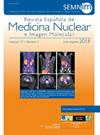Gammagrafía peritoneal y SPECT/CT en el diagnóstico de fugas en pacientes en diálisis peritoneal
IF 1.6
4区 医学
Q3 RADIOLOGY, NUCLEAR MEDICINE & MEDICAL IMAGING
Revista Espanola De Medicina Nuclear E Imagen Molecular
Pub Date : 2025-01-01
DOI:10.1016/j.remn.2024.500067
引用次数: 0
Abstract
Objective
To assess the usefulness of peritoneal cavity scintigraphy and the contribution of SPECT/CT in patients on peritoneal dialysis with suspected leak.
Methodology
An observational case series study is carried out. It consists of a longitudinal, retrospective and descriptive study. 11 patients on peritoneal dialysis were studied and it was realiced a peritoneal cavity scintigraphy test and SPECT/CT to evaluate a peritoneal leak.
Results
In 54,5% of the patients, a positive study of peritoneal leak was obtained. The most frequent localitations were in the abdominal wall at the catheter entry level and the inguinal hernia. In the cases with sintomatology like pain and celullitis of the subcutaneous tract of the cateter the frequent of leak was 100%. There was a change in therapeutic management in patients with a positive study. There was not relevant changes in initial dialysis regimen in patients with a negative study. In this cases, except for one patient who required hemodialysis, all patients experienced clinical improvement.
Conclusions
Peritoneal scintigraphy and SPECT/CT study are non-invasive techniques that allow an adequate diagnosis and subsequent management of peritoneal leak.
腹膜X射线照相和SPECT/CT在诊断腹膜透析患者漏液中的应用
目的探讨腹腔显像及SPECT/CT在腹膜透析疑似渗漏患者中的应用价值。方法采用观察性病例系列研究。它由纵向、回顾性和描述性研究组成。本文对11例腹膜透析患者进行了研究,采用腹腔显像检查和SPECT/CT评估腹膜渗漏。结果54.5%的患者腹膜漏检阳性。最常见的位置是在导管进入水平的腹壁和腹股沟疝。在有鼻窦病变如疼痛和皮下蜂窝组织炎的病例中,漏尿的发生率为100%。阳性研究患者的治疗管理发生了变化。阴性研究患者的初始透析方案无相关变化。在本病例中,除了一名患者需要血液透析外,所有患者的临床症状均有所改善。结论腹腔显像和SPECT/CT检查是非侵入性技术,可对腹膜渗漏进行充分的诊断和后续处理。
本文章由计算机程序翻译,如有差异,请以英文原文为准。
求助全文
约1分钟内获得全文
求助全文
来源期刊

Revista Espanola De Medicina Nuclear E Imagen Molecular
RADIOLOGY, NUCLEAR MEDICINE & MEDICAL IMAGING-
CiteScore
1.10
自引率
16.70%
发文量
85
审稿时长
24 days
期刊介绍:
The Revista Española de Medicina Nuclear e Imagen Molecular (Spanish Journal of Nuclear Medicine and Molecular Imaging), was founded in 1982, and is the official journal of the Spanish Society of Nuclear Medicine and Molecular Imaging, which has more than 700 members.
The Journal, which publishes 6 regular issues per year, has the promotion of research and continuing education in all fields of Nuclear Medicine as its main aim. For this, its principal sections are Originals, Clinical Notes, Images of Interest, and Special Collaboration articles.
 求助内容:
求助内容: 应助结果提醒方式:
应助结果提醒方式:


